Chilling Photographs That'll Change Your Perspective
By | December 16, 2022
Perhaps the last photo ever taken of a very pregnant actress Sharon Tate who was murdered on August 9, 1969, by members of Charles Manson’s followers.
Things aren’t always as they seem. This collection of photographs will show you a view of history – its people, places, and events – that offers a different perspective than what we see in our history books. You will see famous people before they were stars, the final moments of some people’s lives, fads and trends of the past, and some intriguing slices of life in days gone by. History is full of fascinating little tidbits that make for wonderful stories. All we need to do to find them is to change our perspective.
This article originally appeared on our sister site: groovyhistory.com
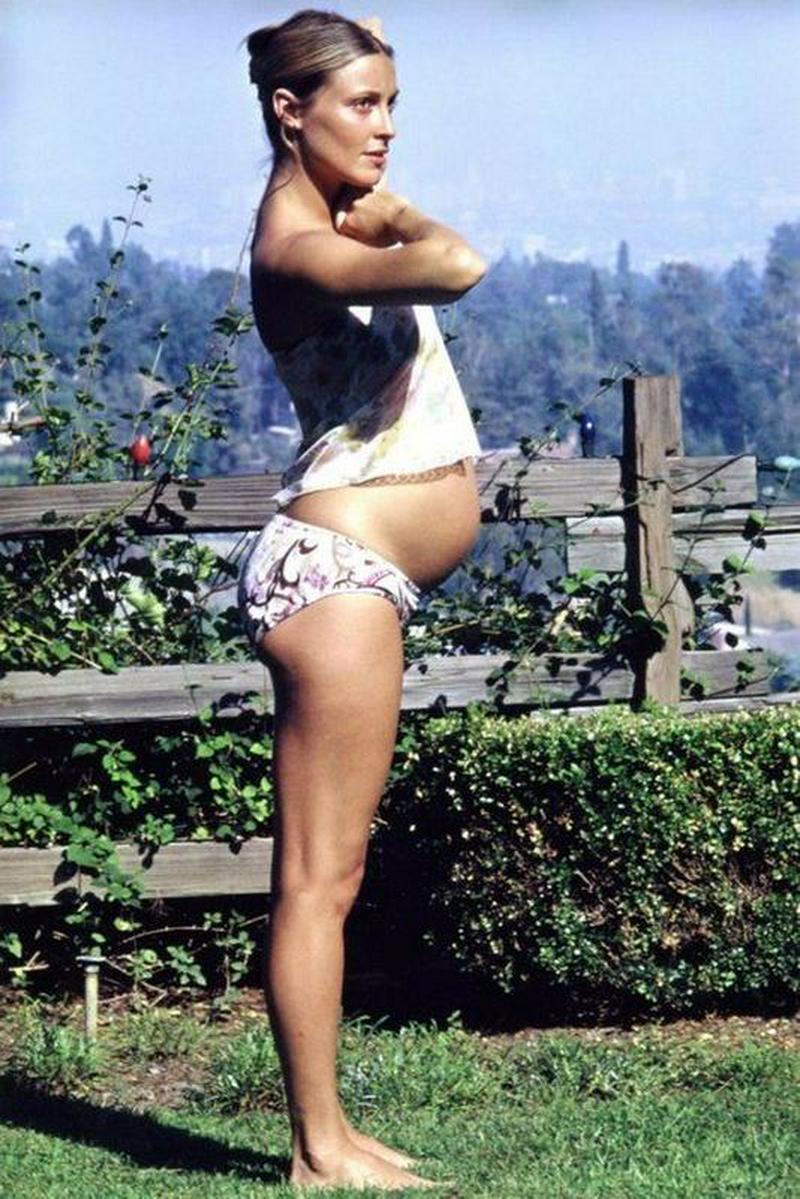
Beautiful actress and model Sharon Tate rose to stardom after her 1967 role in Valley of the Dolls, for which she earned a Golden Globe nomination. By the summer of 1969, Tate seemed to be living a charmed life. Her career was on the rise. She was married to film director Roman Polanski. She was living in a fabulous house in the Hollywood Hills. And she was pregnant with her first child. Who could have predicted that Tate and her friends would be slaughtered in cold blood by members of a murderous cult led by Charles Manson? Just weeks before she was supposed to give birth, Tate and her unborn child were viciously stabbed and killed.
Photographer Roland Reed’s 1910 image, titled “The Eagle”, showed the majestic beauty of the Blackfoot people in their ancestral home in what is now Glacier National Park ⛰️

Roland Reed was a prominent American photographer of the early 20th century who was known for his photographic series featuring Native Americans. Reed, however, was a pictorialist. This artistic movement of the day put an emphasis on artistic arrangement rather than authenticity. The majority of Reed’s photographs of the Blackfoot people, like this one seen here, were staged. Reed sacrificed historical and ethnological accuracy for the sake of a great photograph. Since a collection of his photographs remain, historians are challenged with unraveling the portions of the images that are true to the Blackfoot legacy and which aspects were stages by Reed.
Bill Paxton, Liam Neeson, and Patrick Swayze starred as the Gates brothers in the 1989 action thriller, “Next of Kin”, Two Decades Before Swayze’s Untimely Cancer Death.
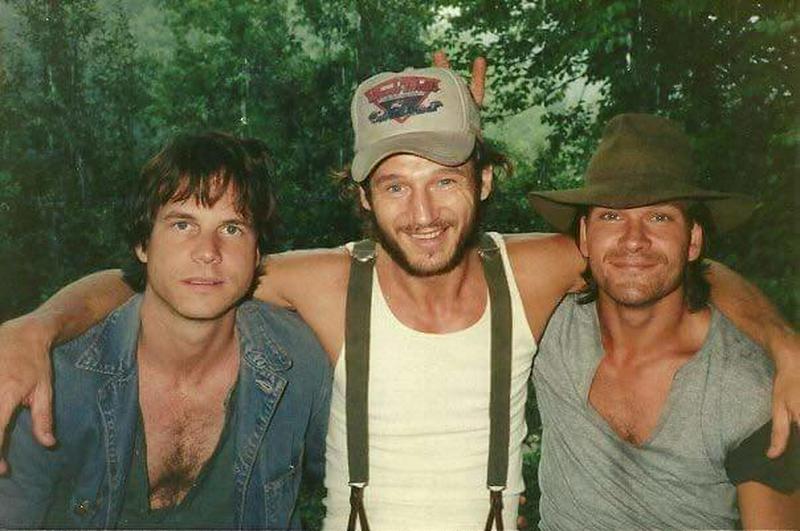
The world was shocked and saddened to hear the news of Patrick Swayze death in 2009. The actor was only 57 when he lost his battle with pancreatic cancer. A prolific performer, Swayze’s career started in the disco era when he appeared in Skatetown U.S.A. in 1979, his first film. Most of the roles Swayze played were that of tough guys with a tender, romantic heart. From Dirty Dancing to Ghost to Road House, he developed a reputation as a heartthrob, but he was a rarity in Hollywood … a happily married man.
Patrick Swayze was just 18 years old when he met Lisa Niemi. She was only 14 at the time. Five years later, on June 12, 1975, they married. Completely and totally in love, the couple were married for 34 years when Swayze died. His iconic 1987 song, “She’s Like the Wind” was written for Lisa.
Noted biologist Alice Eastwood inspecting the fault fissure left behind near Olema, California, after the 1906 earthquake rattled the San Andreas Fault.
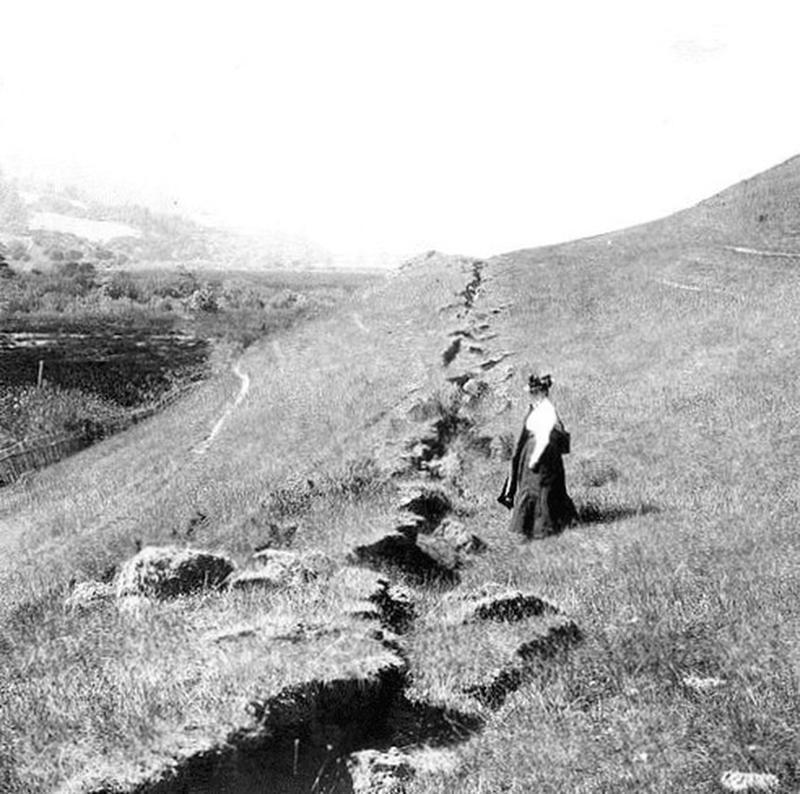
The epicenter of the great San Francisco earthquake of 1906 was actually north of the city near the sparsely populated, Olema, California. As this photograph from the time shows, the fault fissure was clearly visible. It ran for miles. This allowed scientists to study the fault line, even scientists from other disciplines. In this photo, Canadian-born botanist Alice Eastwood is observing the damage. Eastwood, a self-educated botanist, was the head of the botany department at the California Academy of Sciences at the time of the 1906 earthquake. She remained in this position until she retired in 1949. During her tenure, the department enjoyed tremendous growth.

When gold was discovered in California in 1849, the frontier town of San Francisco bloomed into a prosperous city. The wealthy elite all tried to outdo each other with outward shows of opulence which is why San Francisco remains a mecca for old home lovers. One home in particular, the aptly named Cliff House, combines the rugged beauty of the California coast with the stately elegance of the Victorian Era. Designed to be a getaway from the upper crust of San Francisco society, the Cliff House is perched atop a rocky protrusion known as Land’s End. For decades, this resort played host to millionaire business owners, members of high society, celebrities, and presidents.
Outlaw lovers Bonnie Parker and Clyde Barrow knew how to work the media to become household names and romantic figures even as they killed nine police officers and four civilians and robbed numerous banks.
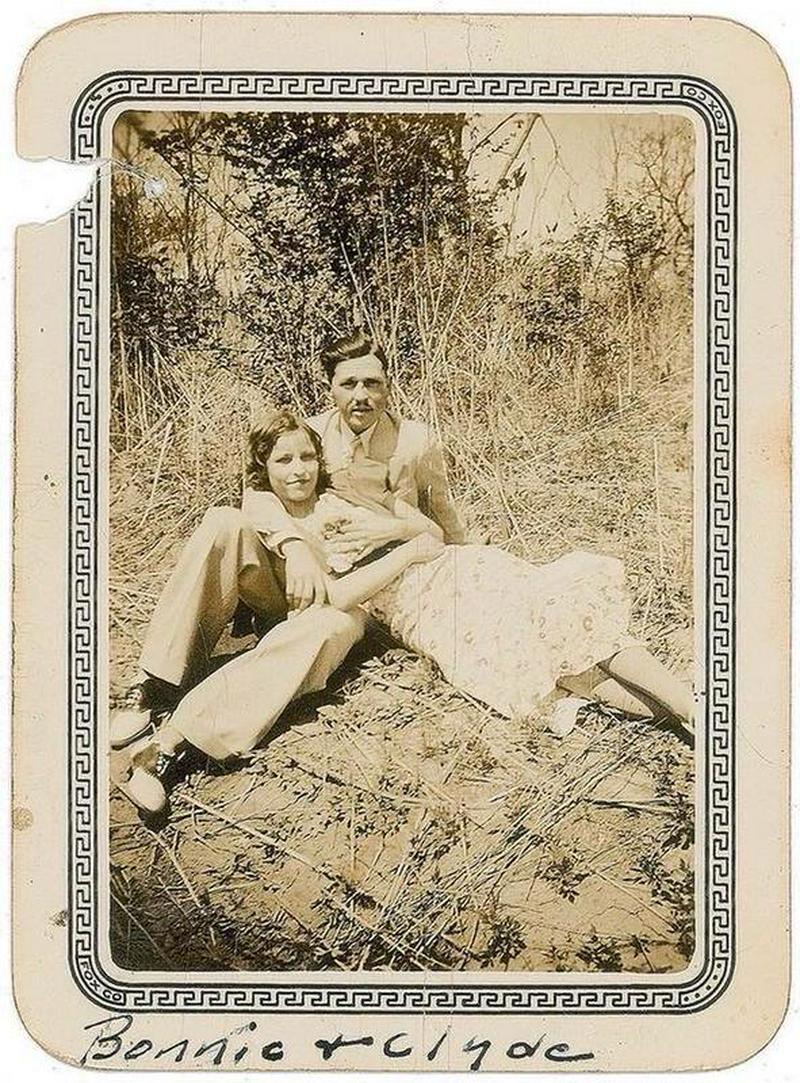
Bonnie and Clyde longed to be famous. Bonnie hoped to be a singer, actress, and dancer. Clyde, who played the saxophone, wanted to be a famous musician. The quest for fame followed them into their criminal lives. The newspapers and crime magazines of the day spread their names across the country with often exaggerated accounts of their outlaw antics. Like an Instagrammer or YouTuber today, Bonnie and Clyde kept their fame growing by producing more content. In their case, it was a series of photographs of them posing with machine guns or pics like this one that emphasis their romantic relationship.
Elaborate and enormous hats were the hallmark of the Edwardian style as this trio of fashionable ladies from 1900 are demonstrating.
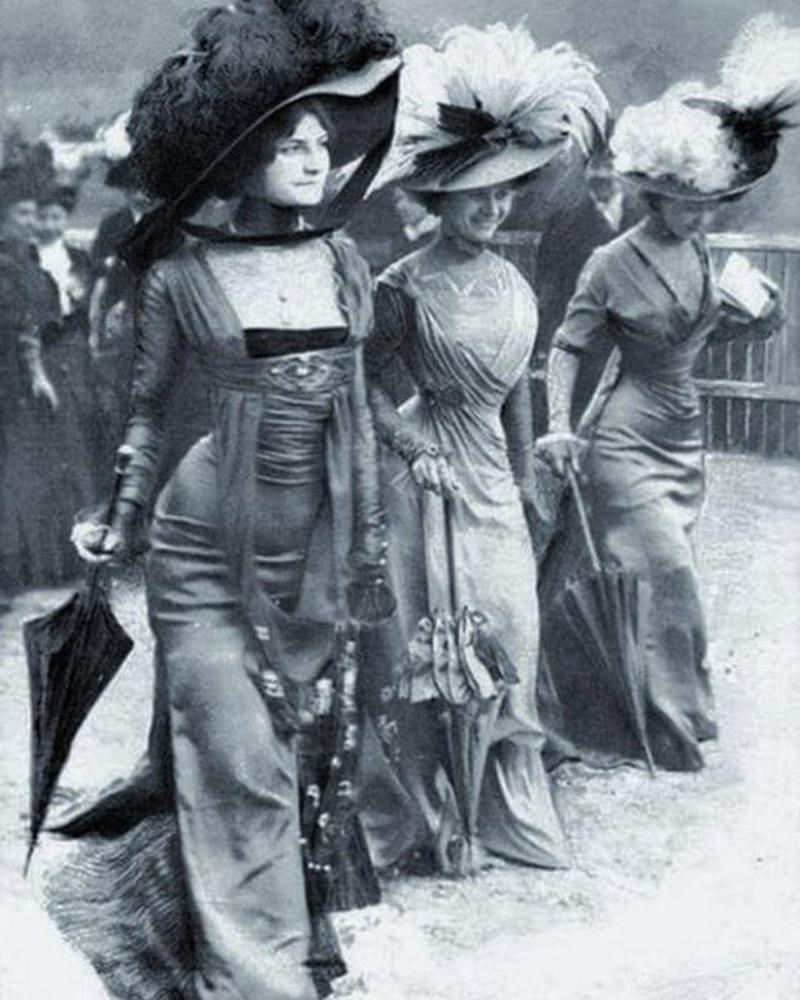
Women’s fashion underwent some drastic changes from the Victorian Era to the Edwardian Era. The full skirts of the Victorian Era gave way to more fitted and tailors dresses and skirts that accentuated the wearer’s figure. Even as the skirts became smaller, the headwear became larger. A hallmark of the Edwardian Era fashion was large, oversized, and elaborate women’s hats, worn atop equally large and elaborate hairstyles. Women piled their braided hair high on their heads … even added false hairpieces to give their updo more height. When the hats were added, there was even more volume. The hats were wide-brimmed and wound with silk or sheer veils or scarved and adorned with beads, feathers, and flowers.
Unearthed in the 1970s in northwest Iran, the Hasanlu lovers were frozen in an eternal kiss for more than 2,800 years.

In the 1970s, an archeology expedition in northwest Iran uncovered the remains of an ancient city called Teppe Hasanlu what has been destroyed more than 2,800 years ago. Among the human remains unearthed were two skeletons that seemed to be kissing. Although this photograph of the skeletons seemed to imply that the couple were lovers in their final embrace before death, modern research may have debunked the “lovers” theory. It is known that the skeleton on the right is that of a young man in his late teens but the skeleton on the left is that of a person in their mid-thirties. The gender of this person could not be determined. Is it a mother and son? A cougar and her boy-toy? Or some other relationship?
Singer Dolly Parton and her husband Carl Dean, a man who stays out of the spotlight, have been happily married since 1966.
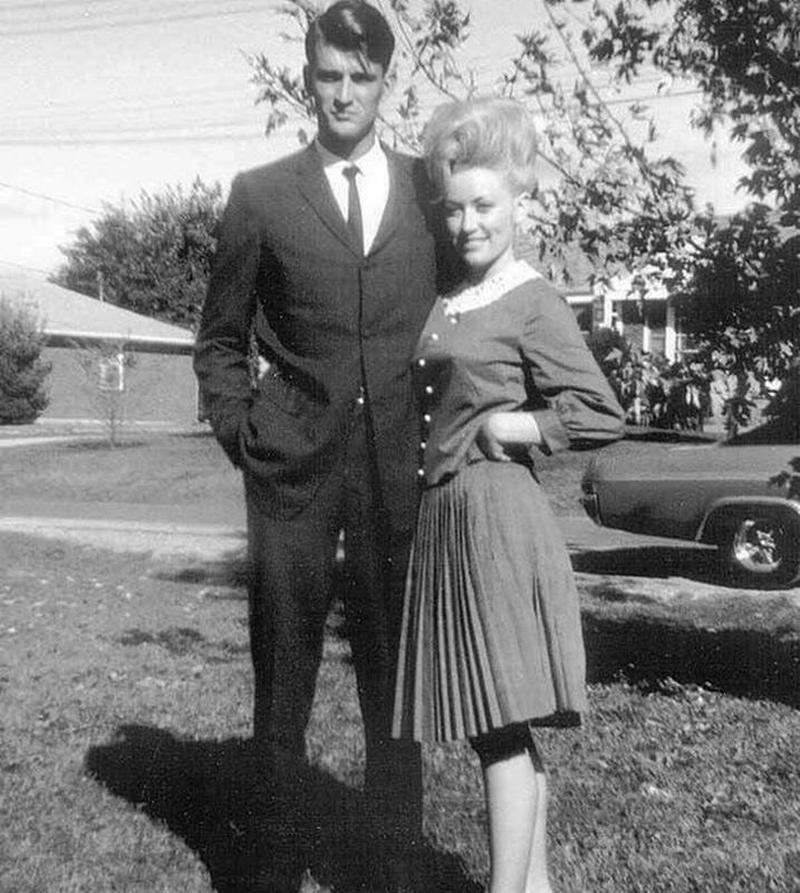
For more than 55 years, the husband of country music superstar Dolly Parton has managed to avoid the spotlight and according to Dolly, that’s just how he likes it. His name is Carl Dean. He and Dolly wed back in 1966 when she was still trying to reach her singing goals. In fact, the couple met on Dolly’s first day in Nashville and it was love at first sight for both of them. A successful businessman, Dean is proud of his wife’s accomplishments but has rarely seen her perform in concert. As Dolly explains, Dean is prone to second-hand stage fright and becomes so anxious when his wife performs that he prefers to stay away.
This 18-foot by 20-foot hole in the side of the Empire State Building, at about the 79th floor, was caused by a disoriented pilot who crashed his B-25 bomber into the skyscraper in heavy fog in 1945.

Decades before the September 11 attacks another plane struck a New York City skyscraper. This incident, which occurred on July 28, 1945, was no terrorist attack, however. It was a tragic accident. It was a foggy morning as Lieutenant Colonel William F. Smith piloted his B-25 bomber from Massachusetts to New Jersey. With near zero visibility, Smith became disoriented. At 9:40 a.m., he crashed into the side of the Empire State Building. Smith, the three people aboard his plane, and eleven people in the building were all killed. The building itself sustained heavy damage, as you can see in this picture, but the structural integrity of the Empire State Building was not compromised.
Wearing this macabre rubber mask, the Beast of Jersey, aka Edward Paisnel, committed a series of heinous attacks on women and children in the 1960s.

For nearly eleven years, the women and children of Channel Island of Jersey were terrorized by a rapist who wore a terrifying rubber mask. The press dubs him the Beast of Jersey. In their eagerness to capture the offenders, police initially arrested the wrong man, a local fisherman. There was no evidence, however, to tie him to the crimes so he was released. The public, however, wasn’t convinced. The innocent man’s home was torched by vigilantes. Eventually, police identified Edward Paisnel as the Beast of Jersey. In December of 1971 he was convicted and sentenced to 30 years in prison.
The beauty was the German commercial sailing ship, the Pamir, which launched in 1905. The last of her kind, the Pamir was outdated by the late-1940s and sank in a hurricane in 1957.

When she was built in 1906, the German sailing ship, the Pamir, was a beautiful steel-hulled, state-of-the-art ship that could reach a top speed of 16 knots. She saw action in World War I and World War II. In fact, she dodged a close call with a Japanese submarine and emerged unscathed. But after four decades of service, the sailing ship was no longer efficient and speedy. Newer, sleeker, speedier sailing ships could pass her with ease. It was no longer profitable to ship cargo on the Pamir. On September 21, 1957, the Pamir was caught in Hurricane Carrie and sank. Only six members of her crew survived.
After Allied Forces liberated the Buchenwald concentration camp in May 1945, U.S. soldiers discovered this cache of wedding rings taken from Jewish prisoners.

When Jewish, Jehovah’s Witness, and Roma Gypsy prisoners were taken to the German concentration camp at Buchenwald, they were stripped of their belongings. The Germans kept a cache of gold wedding rings, seen in this photograph, as well as wristwatches, pocket watches, gold fillings, and other jewelry taken from prisoners. The sheer volume of these wedding rings is a testament to the number of people who were killed in this concentration camp. The camp was liberated on April 11, 1945, by soldiers from the Third Army. More than 21,000 prisoners were freed that day but thousands others who came before them were not so lucky.
The giant African land snail, a species that can get as large as 8 inches long, has invaded Florida in recent years, in part because of the illegal exotic pet trade.

Even though the U.S. Department of Agriculture has made it illegal to import or own a giant African snail, there are still plenty of illegal snail smugglers who supply the exotic pet industry with these enormous snails. But why are they prohibited? It is because pet owners have released their giant African snails into the wild. One of the most destructive snails in the world, this species devours agriculture crops and ornamental plants. It can lay as many as 1,200 eggs a year and survive the chilly temperatures. In addition, the giant African snail is a known carrier of salmonella and other harmful bacteria.
Teenage Ivanka Trump kicking it with her famous dad. Who knew that a few short years later, Ivanka would emerge as the force in her dad’s presidency?

This photograph seems to show a close father-daughter relationship between Donald Trump and his daughter, Ivanka, in her teenage years. In reality, Ivanka has been open about how absent her father was during her childhood. A poor little rich girl, Ivanka was raised by a series of nannies and prestigious schools. She was just 11 when she learned from news reports that her father was having an affair with a model named Marla Maples. It wasn’t until she was an adult and graduated from the University of Pennsylvania with a degree in economics that she grew closer to her famous father.
An all-natural Japanese Geisha without the elaborate makeup, up-do, and costume … a natural beauty, circa 1910.

Geishas were much more than upscale call girls. The geisha tradition runs deep. Geishas are trained in all aspects of gracious hospitality, tea serving, hosting, and much more. Traditionally, geishas grew their hair long so they could style it in elaborate updos to please their clients. They also donned traditional makeup and costumes. It is rare to see a geisha without their makeup, costume, and hairstyles, like the woman shown in this photograph from 1910. The role of the geisha in modern society is controversial. Are they prostitutes or merely companions for hire who will uphold the traditions of Japanese culture?

Someone forgot to hit the brakes. Literally. When the Granville-Paris Express came roaring into the Gare Montparnasse station, the conductor had the train going too fast and he failed to apply the brakes. The train crashed through the station and plowed through the back wall to dangle above the street. Miraculously, none of the passengers or crew on the train were severely injured but, sadly, one innocent person the street below was killed by falling bricks. The train hung from the building for a few days, giving plenty of time for folks to flock to the scene with their cameras for a once-in-a-lifetime photo opp.
With just hours left to live, 36-year-old Princess Diana enjoyed a quiet moment on her lover’s yacht before the couple died in a limousine crash in 1997.

Princess Diana spent the final full day of her life relaxing and enjoying the good life with her lover, Dodi Al Fayed, yet she was still besieged by relentless photographers. Diana dined on fresh croissants, fragrant coffee, and delicious fruit. She laughed and held hands with her boyfriends and basked in the warm sun. The most photographed woman in the world, Diana couldn’t even escape the paparazzi when she was trying to enjoy a moment of solitude. The paparazzi even pursued Diana until her death in a car crash in a Paris tunnel hours later.
Death by firing squad. German officer Anton Dostler being prepared for his execution at the end of World War II.

This photograph captures the final moments in the life of Anton Dostler, a German officer convicted of war crimes in the months following the end of World War II. He was captured by the U.S. Army and faced a war tribunal in 1945. At this trial, Dostler claimed that he did not follow the orders of his superiors, but merely passed on the order to others. He asked for leniency. Instead, he was found guilty of the war crimes and sentenced to death. On December 1, 1945, he was lashed to a post and executed by firing squad. His execution was filmed and photographed.

As far back as the time of the Civil War, photographers tried to capture evidence of ghosts on film. Spirit photography was popular in the late 19th and early 20th centuries. Even Sir Arthur Conan Doyle, the author of the Sherlock Holmes series, was a believer in spirit photography and sought out evidence of it. Spiritualism was a big movement during that time. Folks were eager to believe in ghosts and supernatural spirits. Haunted houses, like the one in this photograph, were hotbeds of spiritual activity. Photographers staked out these places in hopes of capturing a spiritual entity or two on film.

Actress Rita Hayworth, whose real name was Margarita Carmen Cansino, came by her dancers’s legs honestly. She was born into a family of dancers. Rita’s father and grandfather were both dancers and Rita, with the goal of following in her father’s shoes, studied dance. Her first film performance occurred when she was only eight years old when she joined her dancing family on stage. Her dance background was an asset to her when she moved to Hollywood. She appeared in minor roles at first before her big break in 1941 when she danced with the legendary Fred Astaire in You’ll Never Get Rich.
Grotesque and frightening, the gargoyles atop Paris’s Notre Dame Cathedral were meant to ward off evil spirits.
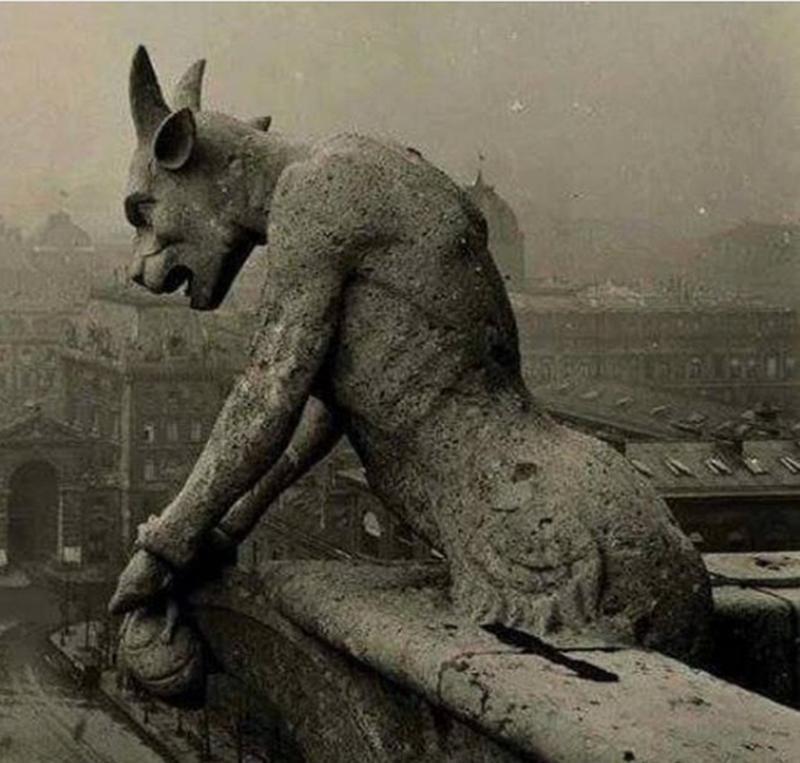
The fearsome gargoyles atop Paris’s Notre Dame Cathedral have been the subject of fascination since the gothic church was built in the Middle Ages. In fact, it is hard to think about the famous cathedral without envisioning its many stone gargoyles. According to legend, the gargoyles were put in place to ward off evil spirits and prevent bad vibes from entering the building. But the gargoyles have another, more practical, function. The stone demons hide the drain spouts that funnel rainwater off the roof to the cathedral. Did you know that no two gargoyles at Notre Dame Cathedral are the same? Each one is unique, giving rise to the idea that each one has its own distinct personality.
Biker Babes of 1949. Lucille Meeker, Betty Drafton, and Cecilia Adams lead a group of riders around LA’s Griffith Park.

Life magazine photographer Loomis Dean was arguably the top photographer for the iconic magazine from 1947 through 1972. He had a knack for capturing slices of American life that represented the spirit of the day. This photograph shows how biker culture of the late 1940s was not about burly guys in sleeveless leather jackets that we would see in the 1960s and 1970s. Instead, it was not uncommon to see average housewives enjoying a motorcycle ride with their husbands or their friends. Here, we see three women, Lucille Meeker, Betty Drafton, and Cecilia Adams, in the lead during a ride around Griffith Park in Los Angeles.
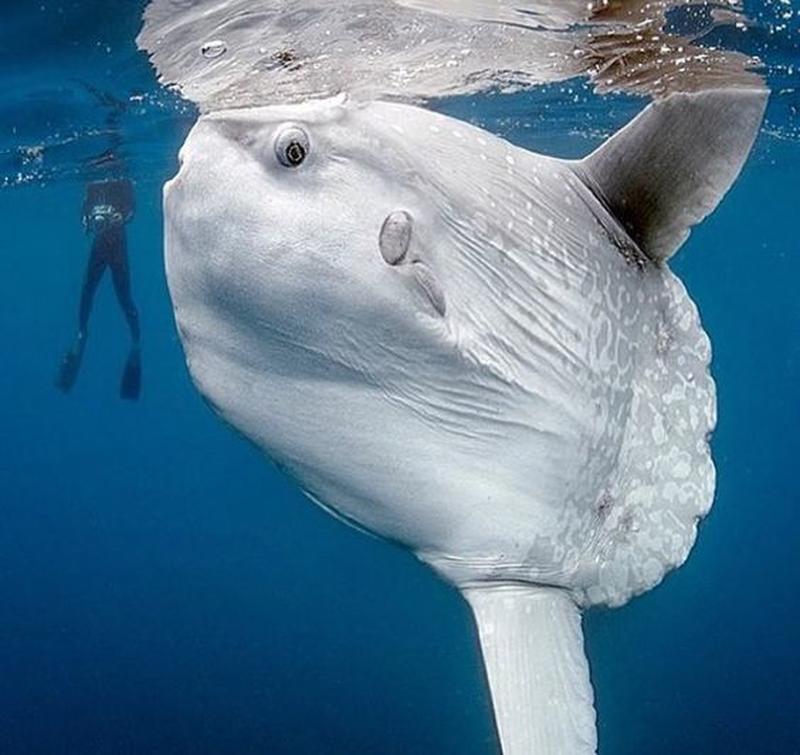
There are all kinds of crazy-looking creatures in the world’s oceans and the giant ocean sunfish is no exception. Even without a tail, the giant ocean sunfish ties for the heaviest bony fish in the world. They can reach more than 4,000 pounds in adulthood. With its shortened body and missing tail fin, the giant ocean sunfish looks like a massive fish head at first glance, but don’t be fooled. This is a complete fish that can maneuver around quite well despite its missing tail fin. Divers are often taken aback by the sight of a giant ocean sunfish but they have no reason to worry. The sunfish eats only smaller fish and crustaceans. It is big but it is not a threat to humans.
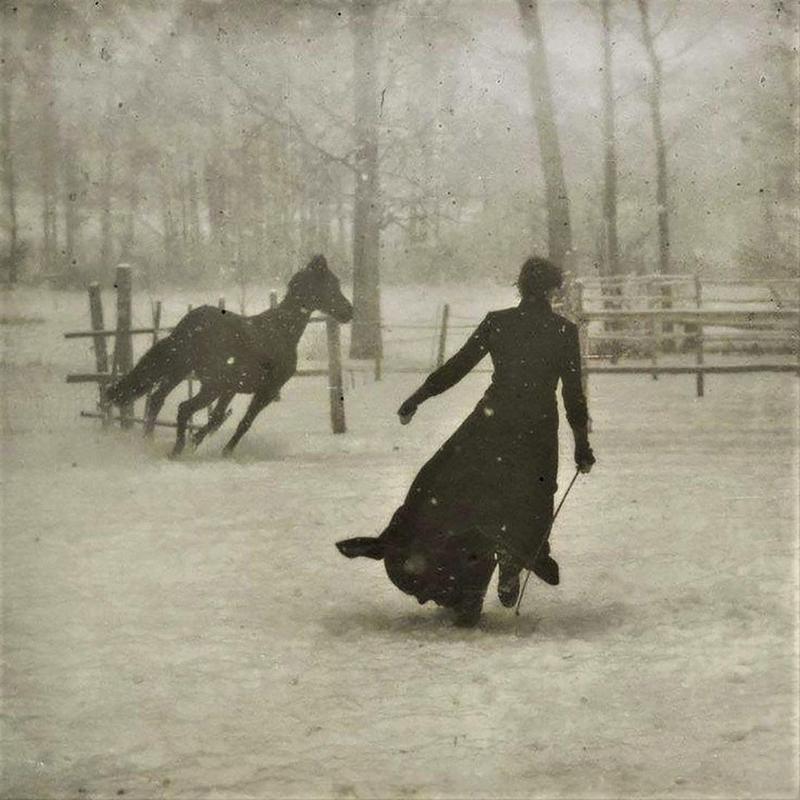
French businessman and industrialist Felix Thiollier didn’t make a living taking photographs, at least not at first. Photography was merely a hobby for him. As an art collector, Thiollier had an artistic eye and saw the world through the lens of an artist. He hobnobbed with noted photographers of the day including Paul Borel, Jean-Paul Laurens, and Francois Guiguet. Bolstered by their feedback, Thiollier took an early retirement to pursue his personal interests in art, photography, and archeology. As for this famous photograph, which Thiollier titled “The Horse Trainer”, Thiollier never identified the woman in the image, but experts believe it may have been one of his daughters.
Cruisin’ in style, three sunseekers soak up the rays on a 1950s houseboat. ☀️

Beginning in the late 1940s, recreational houseboating became popular in the United States. In the years following World War II, Americans experienced an economic boom as well as an increase in modern recreational toys, like houseboats. Kentucky’s Lake Cumberland claims to be the birthplace of recreational houseboating in the U.S. From there, other large lakes in the country adopted the houseboating culture. As these beauties from the 1950s found out, houseboating is a relaxing way to soak up the sun, cool off in the water, and enjoy time with friends. And if the boaters need anything, the houseboat has a kitchen, bathroom, and a bedroom or two.
Pre-Uber, hip, young people thumbed a ride to their destination, oblivious to the dangers.

From the 1930s through the 1970s, one of the most popular modes of transportation was hitchhiking. Hitchhiking was free (though some riders offered the drivers a few bucks for gas) and a generally accepted way for young people to travel. It was not uncommon to hear stories of young hitchhikers who were able to travel from one end of the country to another by thumbing rides with strangers. In the 1970s, law enforcement across the country attempted to put an end to hitchhiking. They launched a public relations campaign suggesting that hitchhiking was dangerous. In reality, a small percent of hitchhikers were killers or rapists, and vice versa.

Working as a tree trimmer in the 1800s was not for the faint of heart. With no ladder trucks or advanced safety gear, the task of removing dead limbs had to be done by hand. Shimmying up the tree and scooting out onto the branches, the workers had to maneuver into place with their saws and gear on their persons and, if they were lucky, a safety rope. Should we mention that workmen’s compensation wasn’t a thing until 1912? All we can say is these tree trimmers better hold on tight.
Lynda Carter was Miss World USA in 1972, three years before donning the patriotic unitard to star in “Wonder Woman”, a role she claims she got simply because she looked like Diana Prince.

An accomplished singer and former Miss World USA, Lynda Carter wanted to try her hand at acting. She landed a few bit part but was fast running out of money when her agent called to tell her that she landed the role of Diana Prince/Wonder Woman in a new TV series. Carter was well aware that she did not land the role on her acting chops alone. It had more to do with her appearance. With her slim figure, dark hair, and blue eyes, she looks a lot like the character in the DC Comic books. The show’s directors informed Carter that “women would be jealous of her” after Wonder Woman hit the airwaves. Carter countered that she planned to play the role in such a way that women were inspired, not jealous. Girl power.
Making fitness look sexy. Farrah Fawcett Majors and hubby Lee Majors out for a jog in LA in 1977.

Two of the hottest actors of the 1970s. Lee Majors, the star of The Six Million Dollar Man, and Farrah Fawcett, the star of Charlie’s Angels, started dating in the late 1960s. The couple married in 1973, much to the delight of celebrity watchers of the day. Majors and Fawcett epitomized the glamorous lives of the beautiful people of LA. Fawcett and Majors separated in 1979 but didn’t officially divorce until 1982. They did not have children together, but they enjoyed staying in shape together by taking frequent jogs through the neighborhood.
Talk about cruel and unusual punishment, Mongolian criminals in the early 1900s were confined to tiny wooden boxes and kept in extreme conditions.

This disturbing photograph, taken in 1913 by French photographer Albert Kahn and published in National Geographic in 1922, shows a convicted woman condemned to a punishment box in Mongolia. A fixture in the Mongolian criminal justice system called immurement, criminals were locked in wooden boxes. They grew mad from isolation, confinement, and impending starvation. The boxes were beastly hot in the day and freezing cold at night. Most criminals quickly died, turning their confinement boxes into their coffins. Thankfully, this treatment of criminals is not outlawed in Mongolia and other parts of the world.
This spooky tunnel of beech trees, known as the Dark Hedges, was planted in Ireland more than a century ago. You may recognize it from “Game of Thrones”.

If this tree lined lane looks familiar to you, it is because it has been featured in The Last Knight and Game of Thrones. Called the Dark Hedges, this lane is located off Bregagh Road in County Antrim in Northern Ireland. The beech trees were planted in 1775 by James Stuart to make a grand entrance to his newly built home, Gracehill House. Numbering more than 150, the beech trees grew to form a tunnel with interlocking canopies. According to local legend, a ghostly spirit known as the Grey Lady can be seen darting from tree to tree in the lane. She may be the spirit of Stuart’s own daughter or, perhaps, one of the housemaids of the manor house.
Construction workers nicknamed the Tacoma Narrow Bridge “Galloping Gertie” because of how it moved in the wind. In 1940, wind gusts cause the bridge to undulate and collapse.

When Leon Moisseiff designed the Tacoma Narrows Bridge, he purposely made the structure flexible enough to move slightly with the wind, however things went terribly wrong shortly after the construction was finished in the summer of 1940. The suspension bridge spanning the Puget Sound was supposed to be a marvel of engineering, but the bridge collapsed in dramatic fashion on November 7. After the accident, researchers were able to learn that the engineers did not factor in the aerodynamic force of the high winds. The winds caused the bridge to sway in an increasingly erratic manner until the concrete broke free and the cables snapped

Don’t believe everything you see on the internet. This remarkable image of a hairy frog is a perfect example. The image went viral and people believed that a new species of fur-bearing frog had been discovered. The image was often accompanied by the frog’s scientific name, Tricho batrachus robustus, so fact-checkers had something tangible to Google. The Tricho batrachus robustus is, after all, the name of a real frog that is native to the Congo, Equatorial Guinea, and Cameroon. But the frog does not have fur. It has been proven that this image is a well-done photoshopped image. Remember, fur is a mammal thing.
1952 was a busy year for starlet Marilyn Monroe. She appeared in five films and weathered a nude pics scandal, and appears on the cover of “Life” magazine.

In 1952, starlet and sex symbol, Marilyn Monroe appeared in an astonishing five films. She had major roles in We’re Not Married, Monkey Business, Clash by Night, O. Henry’s Full House, and Don’t Bother to Knock. She also appeared on the cover of Life magazine wearing a flirty, off-the-shoulder dress. It may have been a banner year for the Hollywood queen except it was the same year that she faces a public scandal. It was revealed that she posed nude for a pin-up calendar back in 1949 before she was a star. Rather than deny the allegations, Marilyn admitted that the photos were of her, but she claimed she did the photoshoot during a time when she was desperate for money. The public forgave her indiscretions.
Child soldier, Hans-Georg Henke of Germany was just 16 when he was captured by U.S. soldiers. He reacted like any child would … by crying.
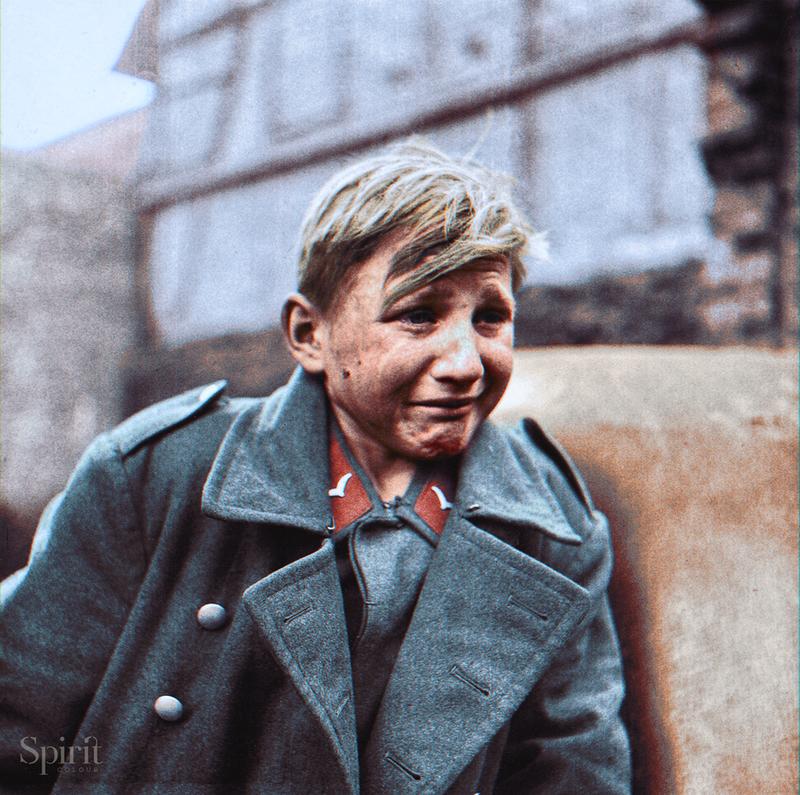
Hans-Georg Henke of Germany had a rough time as a teenager in the 1940s. He father died in 1938 and his mother died in 1944. The 15-year-old was forced to join the Luftwaffe to support his younger siblings. A member of Hitler’s Youth and an anti-aircraft soldier, Henke was trying his best to weather the war and help his family. When Soviet troops advanced on his unit and finally overtook them, young Henke burst into tears. He must have worried about how he would help his family as a prisoner of war, but his tear-streaked face became a symbol for the desperation of the German military, that they would allow children to join.
All over Belgium and France and the Western Front of WWI, German soldiers reinforced their trenches and readied themselves to fight the enemy.

Historians call World War I the “war of trenches”. Machine guns and heavy artillery on the front lines forced both sides to dig in for protection. As the fighting raged, each side tried to breach the other’s trenches. When that happened, the loss of life was horrendous. It moved the fighting from tanks and guns to hand-to-hand combat. The trenches ran red with the blood of the fallen soldiers. The German soldier in this photograph is armed and ready to protect himself, his trench, and his fellow soldiers from an invading enemy. Many trenches left over from World War I still dot the landscape of Germany, France, and Belgium.
Photographer Rocco Morabito was in the right place at the right time in 1967 to capture a daring feat of mouth-to-mouth resuscitation high above the ground.

Electrical utility workers J.D. Thompson and Randall Champion were working on some low voltage lines in 1967 when Champion accidentally made contact with a live line while harnessed to the pole. The shock stopped his heart and breathing. His co-worker, Thompson sprang into action. When he reached Champion, he performed mouth-to-mouth resuscitation until he felt a faint pulse. Then he helped lower Champion to the ground where another co-worker did CPR. Champion survived and lived for another 35 years. Photographer Rocco Morabito was on his way to another assignment when he happened upon the scene. He was able to capture this dramatic photo.
When African American sprinters Jesse Owens and Ralph Metcalfe took gold and silver in the Olympic 100-meter dash in 1936, a Dutch newspaper ran a headline proclaiming bronze medalist Tinus Osendarp of the Netherlands “the best white sprinter at the Summer Olympics”.

American athlete Jesse Owens shattered stereotypes during his historic 1936 Olympic performances. There were many people who were shocked at how easily he beat white athletes. It stirred up a lot of racist sentiments and dashed Hitler’s plans. The German leader hoped to use the 1936 Olympic Games to showcase the superiority of his Aryan athletes. But the African-American track star ruined those plans. Still looking for a way to spin the story after Owens and another African-American sprinter, Ralph Metcalfe took the gold and silver in the 100-meter dash, a Dutch newspaper ran a headline calling the bronze medalist the “best white sprinter at the Summer Olympics.”
Between the 1930s and the 1980s, Iranian women were free to dress and style their hair how they wanted, like this young lady in the 1960s, but the Islamic Revolution of 1979 made the hijab a requirement for all women.
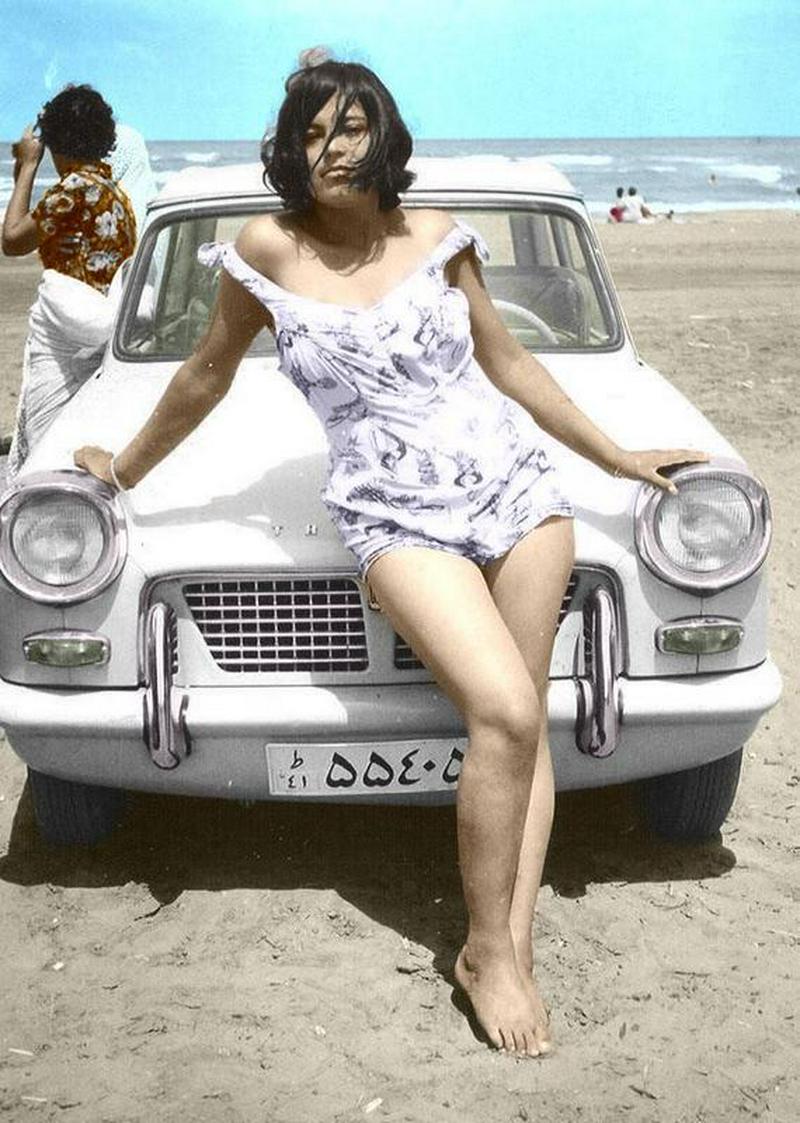
Iranian women were making great strides in the 1950s to 1970s. Thanks in part to the efforts of the Iranian Women’s Movement, women gained the right to vote, hold public office, and divorce their husbands. They enjoyed the freedom to wear whatever they wanted, like the carefree woman in this photograph. Iranian women had one foot in the modern world and were poised to take a big step. All that changed, however, after the Islamic Revolution of 1979. In the years that followed, more and more laws were passed to suppress the rights of women. The most noticeable of these laws had to do with the public dress code for women which required mandatory face veils for all females in public.
Only 4 of the 509 passengers aboard Japan Air Lines Flight 123 survived its crash on August 12, 1985, making it the worst aviation disaster in history.

A faulty repair on the Boeing plane caused a catastrophic loss of cabin pressure on Japan Air Lines Flight 123 on August 12, 1985. Just 12 minutes into its flight, the plane crashed in the heavily wooded Osutaka Ridge. Of the 509 passengers and 15 crew members onboard the flight, only four people survived. When rescuers reached the wreckage, they noted that some of the passengers appeared to have survived the initial crash but succumbed to their injuries before help could arrive. The four survivors were all women who were seated on the left side of the plane near the rear. The crash of Flight 123 still ranks as the worst single aircraft disaster in aviation history.
Thousands of Allied forces landed on the beaches of Normandy on D-Day, June 6, 1944, making this operation the largest amphibious attack.

During the invasion of Normandy in 1944, more than 156,000 Allied ground troops came ashore on the beaches of France to face German troops numbering about 50,000. The heaviest fighting occurred at Omaha Beach. Allied bombing runs failed to destroy the German’s fortified artillery, leaving Allied troops vulnerable as they came ashore. To make matters worse, the beach was lined with mines. Still, the U.S. troops pushed through toward a well-defended seawall and up a bluff to reach the Nazi soldiers. It was a tough fight for the soldiers and a hard-fought victory. In all, roughly 2,400 U.S. soldiers died on Omaha Beach on that one day, June 6, 1944.
More than a pretty face, Brigitte Bardot was the hottest sex symbol of the 1950s and 1960s but she gave that all up when she retired in 1973 to devote her life to animal rights.

Brigitte Bardot earned a reputation as a sex symbol in the 1950s and 1960s. She appeared in more than 40 films and recorded a slew of musical albums. Despite her fame, Bardot felt drawn to activism. In 1973, she walked away from the spotlight to devote herself to a cause that was near and dear to her heart. Animal rights. She used her famous name and even more famous face to raise money for the protection and welfare of animals. She founded the Brigitte Bardot Foundation in 1986 to help further her work in animal activism. She has been outspoken against cultural practices around the globe that have put animals in danger, from seal hunting in Canada to the consumption of horse meat to bullfighting in Spain.
That’s dedication! When a soccer game in 1937 was canceled due to heavy fog, no one told the goalkeeper, Sam Bartram. He remained on the pitch for 15 minutes after the game was called.

Soccer goalkeeper Sam Bartham, who played professionally for the Charlton Athletics, was playing a match against their rivals Chelsea in 1937 when a thick layer of fog settled over the pitch. Bartham later recalled watching as the fog rolled across the field, obscuring the opposing goal and all the players from sight. At first, he could see shadow figures moving in front of him. He kept his eyes peeled for an incoming soccer ball. After a while, he recalled, he noticed that the pitch was eerily silent. Still, he remained at his post. Long minutes passed and then Bartham saw a figure approaching him. To his surprise, it was not one of his teammates or a member of the opposing team. It was a police officer. The officer exclaimed, “What on earth are you doing here? The game was stopped a quarter of an hour ago!”
A dark moment in U.S. history, Japanese-Americans, like these college students in 1942, were rounded up and held in internment camps during World War II.

In the days following the 1941 surprise attack by Japanese bombers on Pearl Harbor, the United States War Department feared that the Japanese may have infiltrated the country. Officials were concerned that Japanese Americans, sympathetic to the cause, they spy on the U.S. or plan further attacks on U.S. soil. The solution was to round up Japanese Americans and hold them in internment camps. The majority of Japanese Americans lived on the west coast, therefore camps were established in California, Washington, Oregon, and other locations. With just a few days to pack and settle their affairs, thousands of Japanese Americans were forced into internment camps to wait out the war.
Like a scene from a horror movie, the figurines at Madame Tussauds Wax Museum in London melted into monstrous figures after a fire broke out in 1925.

Frenchwoman Madame Marie Tussaud had a knack for crafting figures out of wax that so closely resembled the models that it was creepy. She began displaying her wax figures in her home before opening her famous wax museum in London. Her creations attracted huge crowds of admirers. There is one problem with wax, however. It melts. When a fire broke out in the museum in 1925, many of her wax figures were completely destroyed. Many others, like the ones shown in this photograph, survived but were horribly disfigured by the melting wax, turning them into grotesque figures.

Disney added animatronics to its attractions beginning in 1963. The brainchild of Disney employee Lee Adams, the animatronics combines robotics, engineering, and animation to give visitors a quasi-realistic experience. Disney even trademarked the term “audio-animatronics” in 1967. The first animatronic feature at Disney was a small bird, but soon, creators were able to make a human that was programmed to dance. In 1963, Disney opened an attraction called the Enchanted Tiki Room at its Disneyland location. The entire room was filled with animatronic animals and plants that moved in synchronization to a musical score. Visitors in the 1960s marveled at the modern innovations of the Enchanted Tiki Room.

For suburban kids in the 1960s, it was vitally important to have a cool bike. After all, this was the main mode of transportation for teens and pre-teens at that time. Schwinn understood that a cool-looking bike was a must-have. In 1968, they introduced the newest addition to Sting-Ray line, the Schwinn Krate. Taking its name from a popular California dragster, the Krate was a state-of-the-art bike that was as modern and functional as it was attractive. The bike had a drum-style front brake, chrome fenders, and a stick shift mounted on the handlebars. This was the stuff of every 1968 boy’s dreams.
The appropriately named Mammoth was the tallest horse in history. Born in 1848, Mammoth topped out at 7 feet, 2 ½ inches, or more than 21 hands, in height.

The world record holder for the tallest and heaviest horse to ever live belongs to a gelding named Sampson, whose name was later changed to the more appropriate-sounding Mammoth. The horse was bred in Toddington Mills in Bedfordshire, UK, by Thomas Cleaver. To Cleaver’s surprise, the horse grew to an astonishing height. At his peak in 1850, Mammoth measured 21.2 ½ hands in height which converts to 7 feet 2 ½ inches. He topped out at a weight of 1,524 kg,or 3,359 pounds.
Singer, dancer, and actress Joey Heatherton shows off her moves to a surprised Bob Hope and a delighted audience of U.S. service members during a 1965 USO performance.

Singer, dancer, and actress Joey Heatherton was a fixture on the USO tour circuit for more than ten years. She often shared the stage with another USO veteran, Bob Hope, as shown in this 1965 photograph. Although her film career was not remarkable, Heatherton gained fame appearing in variety shows on television. Following her stint with the USO, Heatherton took her act to Vegas and appeared in numerous shows there. Throughout the 1960s and 1970s, she used her reputation as a sex symbol to add a spark to her song and dance routines. From the look on Bob Hope’s face in this photograph, he was intrigued by her dance moves.
Michael Rockefeller's Last Supper, Was the Wealthy Heir Eaten by Cannibals?
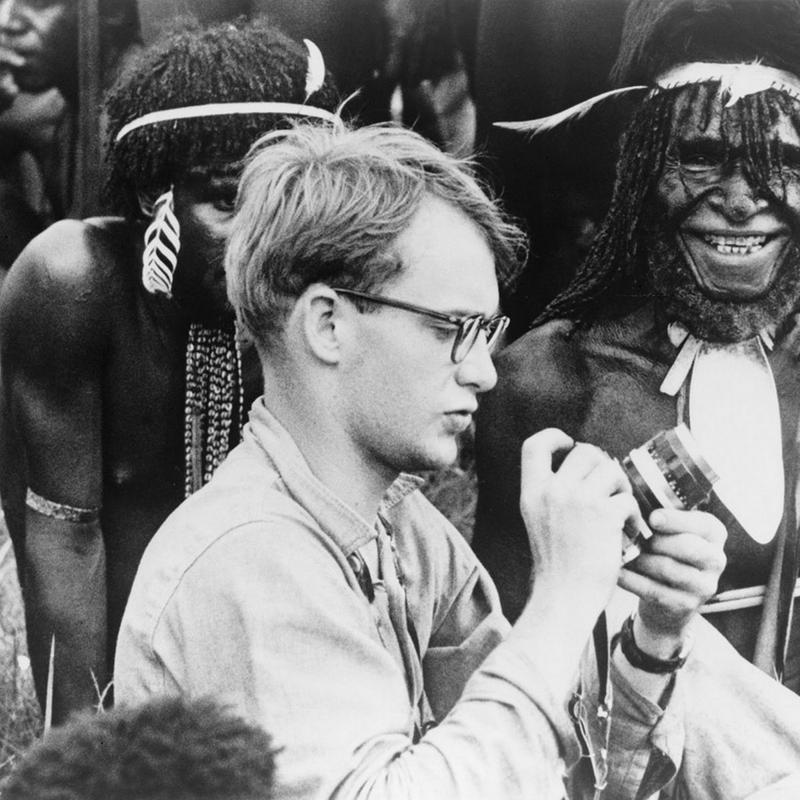
Michael Rockefeller, the youngest son of New York governor Nelson Rockefeller and great-grandson of the business tycoon and uber-wealthy John D. Rockefeller, didn’t have a passion for business like his famous family. Described as artistic and a free spirit, Michael Rockefeller was an adventurer. In the 1960s, he set off on worldwide quests to acquire primitive art. His travels led him to Papua New Guinea, which was then known as Dutch New Guinea so he could view the artwork of the indigenous Asmat people. He found the tribe to be very primitive with strange rituals and practices that were far different than those in the Western world. Intrigued, Rockefeller made a return trip in 1961, this time accompanied by a Dutch anthropologist. On approach to the island, the boat capsized, and Rockefeller tried to swim to shore. He was never seen again. Although his official cause of death was listed as drowning, rumors have circulated that he reached shore and was taken prisoner by the cannibalistic tribe who made Rockefeller their next meal.

